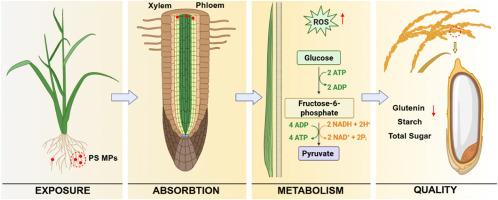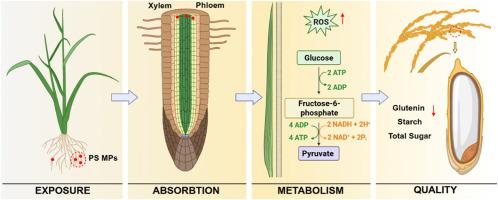聚苯乙烯微塑料和纳米塑料对稻米品质的影响及其代谢机制
IF 7.3
2区 环境科学与生态学
Q1 ENVIRONMENTAL SCIENCES
引用次数: 0
摘要
微纳米塑料(MNPs)对作物生理过程和代谢功能的影响具有大小依赖性,最终威胁作物品质。应密切关注特定规模的反应模式,以便更准确地评估其环境和人类健康风险。本研究采用土壤(10 mg/kg和100 mg/kg)和水培(1 μg/L和10 μg/L)两种暴露系统,研究了粒径为80、100、200、500、800和1000 nm的6种球形聚苯乙烯(PS) MNPs对水稻籽粒品质的影响,并进一步阐明其代谢机制。结果表明,PS MNPs通过水稻根系吸收并向上输送,其在水稻叶片中的浓度在297 ~ 701 μg/g之间。当暴露于直径≤100 nm的PS MNPs (PS≤100 nm)时,植株活性氧(ROS)含量增加了25%,籽粒中谷蛋白含量减少了29%。代谢组学分析表明,水稻叶片糖酵解/糖异生和戊糖与葡萄糖醛酸盐的相互转化与PS MNPs的粒径密切相关。与较大颗粒相比,暴露于PS≤100 nm会降低碳水化合物代谢,减少糖(淀粉、可溶性糖)的积累,从而削弱植物的防御反应。本研究表明,PS≤100 nm时,水稻的防御反应较弱,生物毒性较大,因此在MNPs风险管理和作物安全评估中值得特别关注。本文章由计算机程序翻译,如有差异,请以英文原文为准。


Size-dependent effects of polystyrene micro- and nanoplastics on the quality of rice grains and the metabolism mechanism
Micro- and nanoplastics (MNPs) exhibited size-dependent impacts on crop physiological processes and metabolic functions, ultimately threatening crop quality. The size-specific response patterns warrant close attention to enable a more accurate assessment of their environmental and human health risks. In this study, both soil (10 mg/kg and 100 mg/kg) and hydroponic (1 μg/L and 10 μg/L) exposure systems were employed to investigate the effects of six spherical polystyrene (PS) MNPs particle diameters (80, 100, 200, 500, 800, and 1000 nm) on the grain quality of rice (Oryza sativa L.), and to further elucidate the underlying metabolic mechanisms. The results indicated that PS MNPs were absorbed through rice roots and transported upward, with concentrations in rice leaves ranging from 297 to 701 μg/g. When exposure to PS MNPs with diameters ≤100 nm (PS ≤ 100 nm), the reactive oxygen species (ROS) levels in the plants increased by 25 %, and glutenin content in the grain decreased by up to 29 %. Metabolomic analysis revealed that glycolysis/gluconeogenesis and pentose and glucuronate interconversion in rice leaves were closely associated with the particle diameters of PS MNPs. Compared to larger particles, exposure to PS ≤ 100 nm downregulated carbohydrate metabolism and decreased the accumulation of sugars (starch, soluble sugars), thereby weakening the plant's defense response. This study demonstrated that PS ≤ 100 nm triggered weaker defense response in rice, leading to greater biotoxicity, thereby deserving particular attention for governing the MNPs risk and crop safety assessment.
求助全文
通过发布文献求助,成功后即可免费获取论文全文。
去求助
来源期刊

Environmental Pollution
环境科学-环境科学
CiteScore
16.00
自引率
6.70%
发文量
2082
审稿时长
2.9 months
期刊介绍:
Environmental Pollution is an international peer-reviewed journal that publishes high-quality research papers and review articles covering all aspects of environmental pollution and its impacts on ecosystems and human health.
Subject areas include, but are not limited to:
• Sources and occurrences of pollutants that are clearly defined and measured in environmental compartments, food and food-related items, and human bodies;
• Interlinks between contaminant exposure and biological, ecological, and human health effects, including those of climate change;
• Contaminants of emerging concerns (including but not limited to antibiotic resistant microorganisms or genes, microplastics/nanoplastics, electronic wastes, light, and noise) and/or their biological, ecological, or human health effects;
• Laboratory and field studies on the remediation/mitigation of environmental pollution via new techniques and with clear links to biological, ecological, or human health effects;
• Modeling of pollution processes, patterns, or trends that is of clear environmental and/or human health interest;
• New techniques that measure and examine environmental occurrences, transport, behavior, and effects of pollutants within the environment or the laboratory, provided that they can be clearly used to address problems within regional or global environmental compartments.
 求助内容:
求助内容: 应助结果提醒方式:
应助结果提醒方式:


